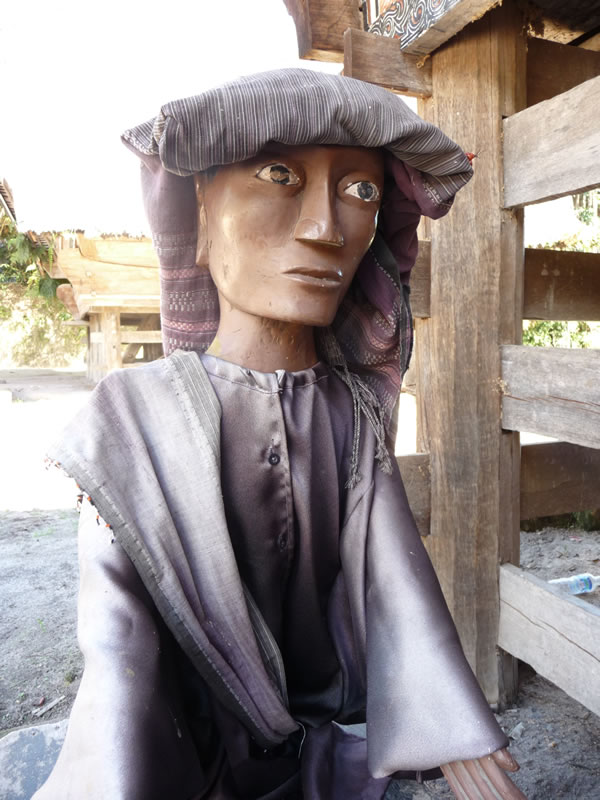The Work of Reviving Batak Textiles

To grow enough plants to make the natural dyes requires time and patience.
When Threads of Life and the Bebali Foundation began to work in Sumatra last year with the support of Sandra Niessen and funds from the Dutch Embassy, we initially focused on the area of Muara on the south end of Lake Toba with the aim of helping traditional weavers recover their natural dye processes. After a year, the colors are beginning to emerge but we still have a ways to go. Growing enough dye plants to make the colors will take time and patience.
In the meantime weavers in Muara are focused on producing one textile a week, using synthetic dyes, which they take to the weekly market for cash that pays the fees for their children’s school fees.

Sauruli Siregar still weaves synthetically dyed threads even though she is able to dye using indigo.

Sigale gale is a wooden puppet that is danced during traditional ceremonies.
On this trip we had the opportunity to see a traditional sigale gale performance on Samosir Island. The sigale gale is a wooden puppet dressed in traditional clothing. It is said to represent the beloved son of a king. The son became ill and died and the puppet was created so that the king could remember how joyous his son was when alive. Now this puppet is danced for ceremonies in the traditional houses around Samosir island.
The dancers in the traditional compound of Samanindo on Samosir Island still perform dances in honor of the ancestors. I was surprised to hear that the name that Batak use to speak of their ancestor is Batara guru which is the same name we use in Bali to speak of our ancestors. In Bali we call the Divine “”Sanghyang Widhiwasa””, while the Batak use the name, Mulajadi Nabolon.

Simanindo compound where traditional dances are often performed for tourists but are still performed at ceremonies.

Hotmawati Pasaribu showing a sadum she made for Threads of Life.
From Muara and Somosir we also visited weavers in Tarutung which is most famous for a textile called a sadum. Threads of Life feels that the techniques of making a sadum textile are important to conserve. It uses a supplementary weft threaded with beads. We hope to move back to natural dyes but it will take time to teach the skills and can be done only when the weavers trust we will be around to work with them for a long time and see there is an economic advantage.
Weaver Hotmawati’s son Rickki Rikardo has loved weaving since he was small and helps his mother. When I got back to Bali Jean and William told me that Ricky Ricardo was the name of a well-known character in a 1950s TV show called I Love Lucy! I wonder if Hotmawati knew that or where that name came from? Hotmawati’s daughter also helps with the weaving. Both do this work after their school studies as Hotmawati values their education first.

Hotmawati’s son, Rickki Ricardo, is now 16 and has been weaving since he was 12.

Ompu Marni, here weaving a ragidup, is dedicated to this work while her daughter prefers to weave gold-thread songket that sell for more.
The most popular textile woven in Taruntung is the songket. Young weavers want to weave these as the demand is high and the price is good. These textiles are beautiful but it means the more traditional textiles, such as the ragidup, are only being woven by older women such as Ompu Marni.
We continue to be positive about our work in this fascinating area of Sumatra but recognize that it will take a long time before the natural dye work is revived in both Muara and Tarutung. Building trust so that weavers believe us enough to try to develop natural dye skills is our focus.

The batak culture of Sumatra is fascinating and rich. It will take time to build relationships.

